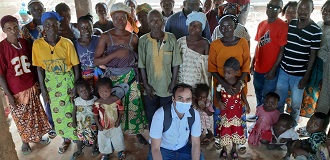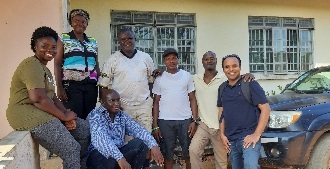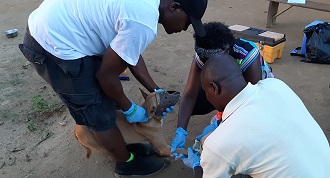
PANDORA Programme
The PANDORA programme is about understanding the socio-ecological drivers of emerging zoonosis and persistence of transboundary pathogens at human/environment/wildlife/domestic animal interfaces in contrasted landscapes as a means to trial novel veterinary, medical and preventive solutions. PANDORA is the core programme and other projects have arisen from this platform, including a Queen Mary’s led UKRI GCRF COVID Lockdown Project and an IDRC funded West-African One-Health Action for Mitigating Outbreaks project.

Challenge
The PANDORA programme involves a consortium of partners in Europe and Africa working with a One Health Approach to prepare African countries to improve knowledge, preparedness and response to emerging infectious disease challenges. The emergence pathways are complex and current health systems are poorly equipped to investigate and respond to these infections arising from a variety of human, animal and environment sources. The One Health approach proposes a solution to this gap in health and disease knowledge and management and defined as:
“One Health is an integrated, unifying approach that aims to sustainably balance and optimize the health of people, animals and ecosystems. It recognizes the health of humans, domestic and wild animals, plants, and the wider environment (including ecosystems) are closely linked and inter-dependent. The approach mobilizes multiple sectors, disciplines and communities at varying levels of society to work together to foster well-being and tackle threats to health and ecosystems, while addressing the collective need for clean water, energy and air, safe and nutritious food, taking action on climate change, and contributing to sustainable development. Joint Tripartite” (FAO, OIE, WHO) and UNEP Statement Tripartite and UNEP support OHHLEP’s definition of “One Health” 2021.
The RVC team has been working since 2018 collaboratively within the PANDORA partnership on a range of bacterial and viral diseases with zoonotic origins or true zoonoses, including: Lassa fever and Monkeypox (prospective. retrospective and socioecological studies SES), and vector borne diseases: Rift Valley fever, dengue, zika and chikungunya virus (outbreak studies and SES) and, anthrax and tuberculosis (exploratory and surveys) in sub-Saharan African countries (Sierra Leone, Nigeria, Ghana, Tanzania, Sudan and Republic of Congo). During COVID, the team has worked extensively on collaborating partner data sources from Lockdown Studies (with Queen Mary’s University), on publicly available covid case and epidemiological data to determine risk factors and provide commentary on zoonotic origins that are proposed for this emergent human pathogen. Work is to be extended through an IDRC funded project in Liberia, Guinea, Sierra Leone and Nigeria on COVID, monkeypox and Lassa Fever 2021-2024.
The RVC is coordinating work on establishing a valid cross species serological test protocol for target diseases in animals (domestic and wild) to improve epidemiological surveillance including for Lassa fever and monkeypox. Using both developed and novel serology and antigen/genome diagnostic tools provide a baseline of likely host pathogen community prevalence’s in West Africa and explore associations with various socioecological risk factors.
Lassa fever in West Africa:
Lassa fever (LF) is a viral zoonotic illness caused by an arenavirus and is responsible for severe haemorrhagic fever characterised by fever, muscle aches, vomiting, chest and abdominal pain with several complication including deafness1. The disease is endemic in West Africa including Nigeria (Nig) and Sierra Leone (SL) 2–6. Based on studies in 1980’s LF affects around 200,000-300,000 people and causes 5000-10,000 human death each year in West Africa 7. However, in the last 35 years, the population of sub-Saharan Africa (SSA) has doubled and crop production has intensified in the entire region resulting in severe damage to forests and ecosystems 8. Humans are believed to get the infections through touching objects contaminated with rodent urine, breathing aerosolised particles, being bitten by rodents or consuming rodents 9–11 . Human to human transmission can occur occasionally in hospital settings and in community 7,12,13. Other bridge species are not known currently. Mastomys natalensis is the primary reservoir of LF 16,17, however, two other species, Mastomys erytholeucus and Hylomyscus pamfi were recently identified as a reservoir of LFV 18,19.
Domestic (cattle, sheep, goats) and peri-domestic (cats and dogs) animals are exposed to rodents 3 but little is known whether they can be infected, and might be a source of infection or a bridge host. One of the reasons for this gap in knowledge is a lack of suitable serological tests validated across the more common species. For example, cats have been promoted in rodent killing programs but whether the cats can become infected and be a source of transmission has not been studied. Likewise, no information is available whether squirrels play any role in the epidemiology of LFV transmission.

Solution
• To identify geographical hotspot(s) (space-time clustering) of human LF cases in SL based on available data
• To establish a valid cross species serological test for LFV antibody in animal serum and evaluate sero-prevalence of LFV antibodies in humans and in domestic and peri-domestic animals in SL
• To corroborate an association between perceived contact with rodents and other animals and confirmed LF cases according to rural to urban gradients (case control study)
• To compare prospectively the ecosystem and socio-ecology of two endemic areas
• To propose pilot interventions to trial and mitigate identified risk based on a SES approach
• To explore rodent communities and their association with LFV in different ecological landscapes in a high-risk zone (PhD project)
This includes an exploratory study on serological evidence of antibodies against LFV in different animal species within a known prevalence in associated human community. As LFV is a mammalian adapted virus, we will test a broad range of mammal species potentially exposed to rodents. The animals tested will include cats, dogs, pigs, cattle, sheep and goats depending on their abundance and any wildlife within the LVF ecosystem (defined above).
We will use both serum from biobanks and actively collected samples from the study sites and associated slaughterhouses. We will first establish luciferase immunoprecipitation system in the Njala laboratories to detect antibodies against LFV in animals. The test was developed by the International Atomic Energy Agency (IAEA) and has shown higher sensitivity and specificity to detect antibodies against Peste des Petits Ruminants Virus (PPRV) compared to commercially available competitive enzyme-linked immunosorbent assays (cELISA) with no cross-reactivity against rinderpest virus 29. We will collect blood (sera) samples a total 250 dogs and 250 cats samples from LF endemic areas of Sierra Leone. The sera samples will be tested using LIPS at Njala University in Sierra Leone. Other activities are summarised below.
Table 1: Objectives, outcome, and analysis plan for field epidemiological studies on Lassa fever virus in Sierra Leone
| Objectives | Data type/ Output | Analysis plan |
| Objective 1 (retrospective observational study) | Time series LF incidence data, Geographical clustering | k-function test |
| Objective 2 (Case-control study) | Risk factors (Adjusted odd ratios) | Multiple Conditional Logistic regression |
| Objective 3(Cross sectional study) | Sero-prevalence of LF in different animal species | Chi-square, t-test |
| Objective 4(prospective observational study) | Socio-ecological system | SES system models, Chi square / t tests Qualitative summery analysis |
| Objective 5(Intervention study) | Pilot intervention study | Chi-square, t test |

Impact
Wildlife Community Hosts for LFV and landscape associations: A more detailed understanding of rodent communities in developing landscapes in a high LVF risk area of Sierra Leone and their associations with the virus through viral detection methods and serology.
Animal reservoirs: Despite a half a century of research on LFV, the role of domestic and peri-domestic animals in maintenance of LFV is not well known. We will explore whether these animals (cats, dogs) play a role in the transmission cycles of LFV. Samples (blood, sera) has been collected from 202 cats and 25 dogs of Lassa fever endemic district Kenema in Sierra Leone. The samples awaiting for testing for evidence of LFV infection. More samples are planned to collect.
Diagnostics: There is no commercial diagnostic kits available for testing animal samples, despite human diagnostics are prepared by several companies. In collaboration with IAEA, we will develop LIPS diagnostics test, that will be usable in any species of animals.
Risk factors: Several studies identified individual level risk factors for LFV infection. We will explore community and geography level risk factors for occurrence of new LF outbreaks.
Geospatial clustering: We will explore space-time clustering of LF outbreaks in Sierra Leone. This will help piloting intervention in specific areas and particular season of the year.
Rodents’ movement at night: Using the infra-red camera, we will explore how the rodents get access to household foodstuff and how it contaminates the utensils. This will help us design household level intervention studies.
Palm squirrels’ role LFV epidemiology: Squirrels move around the oil palm tree and get access to palm sap. We will collect specimens from 250 rope and palm squirrels and test the species for LFV antibodies. This will be the first study to explore evidence of LFV infection in any of the squirrel species.
Partners and Funding
PANDORA-ID-NET was funded by European and Developing Countries Clinical Trials Partnership (EDCTP2) programme, which is supported under Horizon 2020, the European Union's Framework Programme for Research and Innovation. The IDRC One Health research project is funded by Canadian International Development Research Centre.
Publications
News / In the media:
1) RVC researcher part of emergency international response to disease outbreak in the Congo:
A post-doctoral researcher from the RVC is part of an international consortium of experts, PANDORA ID NET, that responded to an outbreak of Chikungunya in the Republic of the Congo. The team is investigating the spread of the serious viral disease, which causes fever and joint pain and is transmitted via mosquitos, and undertaking valuable research which will assist further efforts to combat the disease. Dr Najmul Haider from the RVC is assessing the circulation of the virus in mosquitos and other wild animals, known as its ‘sylvatic cycle’. To do so, he is taking where possible samples of the virus from the rodents and non-human primates which play a major part in perpetuating the disease. Dr Haider and the PANDORA team also aim to develop a mathematical model with the meteorological and vector abundance data, which can predict the size of the outbreaks in humans in Congo. They will create socio-ecological models which will examine drivers of emergence of the epidemics in Congo.
2) Covid-19—zoonosis or emerging infectious disease?
The World Health Organization defines a zoonosis as any infection naturally transmissible from vertebrate animals to humans. The pandemic of Coronavirus disease (COVID-19) caused by SARS-CoV-2 has been classified as a zoonotic disease, however, no animal reservoir has yet been found, so this classification is premature. We propose that COVID-19 should instead be classified an “emerging infectious disease (EID) of probable animal origin.”
The articles got huge media attention with 8 news report, including in The Wire, The Conversation and Trial Site.
'The Global Case-Fatality Rate of COVID-19 Has Been Declining Since May 2020': The article is featured on this notable blog This Week in Virology (TWiV).
